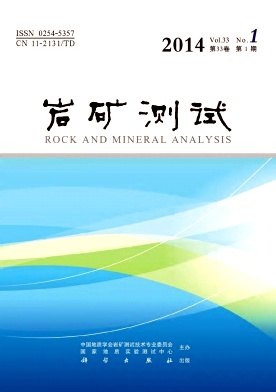| Citation: | tao Zhou, bin Han, yayan Xu, xinmin Liu, li Zheng, xiaoru Wang. Concentrations and Distribution Characteristics of Organochlorine Pesticides and Polychlorinated Biphenyls in Seawaters of the South Sea[J]. Rock and Mineral Analysis, 2014, 33(1): 90-95. |
Concentrations and Distribution Characteristics of Organochlorine Pesticides and Polychlorinated Biphenyls in Seawaters of the South Sea
-
Abstract
In recent years, with the operation of coastal chemical production bases and booming maritime transportation of dangerous chemicals, there are threats to the marine environment. Persistent organic pollutants, such as organochlorine pesticides (OCPs) and polychlorinated biphenyls (PCBs), have been detected in the offshore marine environment. In order to understand the pollution status of persistent organic pollutants (POPs) in the South China Sea, 15 PCBs and OCPs in seawater from the South China Sea were quantitatively determined by using Gas Chromatography- Electron Capture Detector (GC-ECD). Six kinds of OCPs and six kinds of PCBs were detected in these seawater samples. Using an external standard method for quantitative analysis, the detection limits were 0.24-1.07 ng/L, the linear range of the method was 1.0-250 ng/L. The recoveries for blanks were in the range of 89.1% to 109.7% with the relative standard deviations of 2.3%-8.6% and the recoveries for the samples were in the range of 90.1% to 113.5% with the relative standard deviations of 3.1%-10.4%. The results show that the concentration ranges of OCPs and PCBs were 0-92.30 ng/L and 1.16-76.24 ng/L respectively in the surface seawater, 0-69.85 ng/L and 0-49.63 ng/L in seawater from the depth of 200 m, and 0-56.68 ng/L and 0-26.47 ng/L in seawater from the depth of 500 m. The distribution of the contents of OCPs and PCBs tend to be highest in surface water, and lower in 200 m depth layer, and lowest in 500 m depth layer. The main possible pollutant sources are nearby surface runoff and atmospheric input. The pollutants were absorbed by suspended substances and transported from surface to deep seawater column. The detected OCPs and PCBs levels in the South China Sea are lower than those in other offshore marine environments in China, but higher than those in other countries with published data. The concentrations and distribution characteristics of OCPs and PCBs in the South China Sea, provide basic data for future research. -

-
References
[1] 翁焕新,朱扬明,彭晓彤.有机污染物在不同沿海沉积环境中的积累的差异性[J].海洋学报,2004,26(2): 45-51. [2] Basheer C, Obbard J P, Lee H K. Persistent organic pollutants in Singapore’s Coastal marine environment: Part Ⅰ, Seawater [J].Water, Air and Soil Pollution,2003,149: 195-313. [3] 王泰,张祖麟,黄俊,胡红营,余刚,李发生.海河与渤海湾水体中溶解态多氯联苯和有机氯农药污染状况调查[J].环境科学,2007,28(4): 730-735. [4] [5] 曹磊,韩彬,郑立,杨东方,王小如,孙丕喜.桑沟湾水体中有机氯农药和多氯联苯的浓度水平及分布特征[J].海洋科学,2011,35(4): 44-50. [6] GB 3097—1997,海水水质标准[S]. [7] US EPA. EPA-822-R-02-047,National Recommended Water Quality Criteria [S]. 2005. [8] Krauss M, Wilcke W. Predicting soil-water partitioning of polycyclicaromatic hydrocarbons and polychlori-nated biphenyls by desorption with methanol-water mixtures at different temperatures [J].Environmental Science & Technology,2001,35(11): 2319-2325. [9] 王子健,黄圣彪,马梅,王毅.水体中溶解有机物对多氯联苯在淮河水体沉积物上的吸附和生物富集作用的影响[J].环境科学学报, 2005,25(1): 39-44. [10] Zhang Z L, Hong H S, Zhou J L, Huang J, Yu G. Fate and assessment of persistent organic pollutants in water and sediment from Minjiang River Estuary, Southeast China[J].Chemosphere,2003,52(9): 1423-1430. [11] 谭培功,赵仕兰,曾宪杰,李静.莱州湾海域水体中有机氯农药和多氯联苯的浓度水平和分布特征[J].中国海洋大学学报,2006,36(3): 439-446. [12] 谭培功,赵仕兰,曾宪杰,李静.莱州湾海域水体中有机氯农药和多氯联苯的浓度水平和分布特征[J].中国海洋大学学报,2006,36(3): 439-446. [13] 聂湘平,蓝崇钰,栾天罡,魏泰莉,黄铭洪.用SPME 测定珠江河口水体中的PCBs [J].海洋环境科学, 2002, 21(2): 65-68. [14] 杨清书,麦碧娴,傅家谟,盛国英,王静新.珠江干流河口水体有机氯农药的时空分布特征[J].环境科学,2004,25(2): 150-156. [15] 管玉峰,岳强,涂秀云,吴宏海.珠江入海口水体中多氯联苯的分布特征及其来源分析[J].环境科学研究,2011,24(8): 865-872. [16] 窦薇,赵忠宪.白洋淀水体、底泥及鲫鱼体内DDT、BHC污染状况研究[J].环境科学学报,1998,18(3): 308-312. [17] Dai G H, Liu X H, Liang G, Han X, Shi L, Cheng D M, Gong W W. Distribution of organochlorine pesticides (OCPs) and poly chlorinated biphenyls (PCBs) in surface water and sediments from Baiyangdian Lake in North China[J].Journal of Environmental Sciences, 2011,23(10): 1640-1649. [18] 张祖麟,洪华生,哈里德,周俊良,陈伟琪,徐立.厦门西港表层水体中有机氯农药和多氯联苯的研究[J].海洋环境科学,2000,19(3): 48-51. -
Access History

- Figure 1. Sampling stations in the South China Sea
- Figure 2. Chromatogram of OCPs and PCBs standards (50 μg/L)





 DownLoad:
DownLoad:
